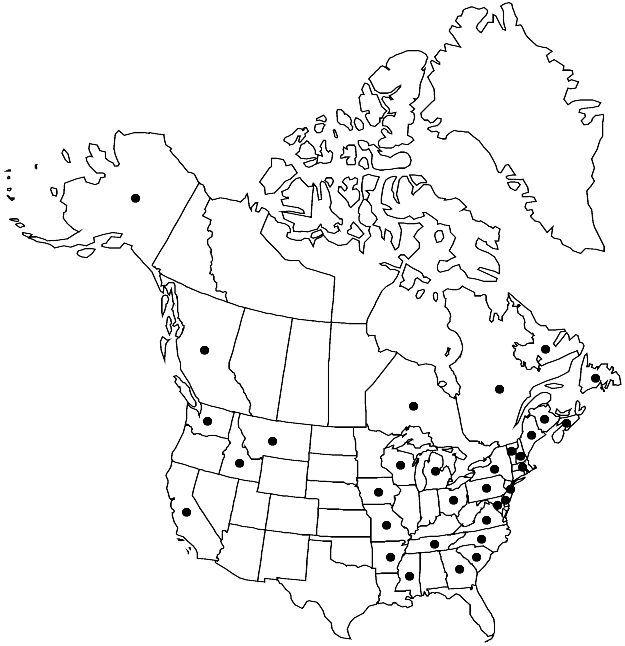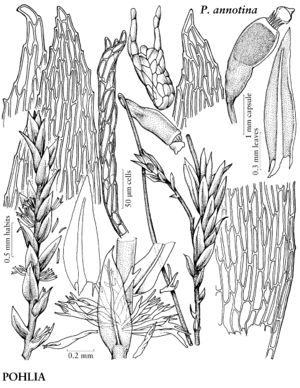Difference between revisions of "Pohlia annotina"
Musc. Scand., 17. 1879.
FNA>Volume Importer |
FNA>Volume Importer |
||
| Line 30: | Line 30: | ||
|elevation=low to high elevations | |elevation=low to high elevations | ||
|distribution=B.C.;N.B.;Nfld. and Labr.;N.S.;Ont.;Que.;Alaska;Ark.;Calif.;Del.;Ga.;Idaho;Iowa;Maine;Md.;Mass.;Mich.;Miss.;Mo.;Mont.;N.H.;N.J.;N.Y.;N.C.;Ohio;Pa.;S.C.;Tenn.;Vt.;Va.;Wash.;Wis.;Europe. | |distribution=B.C.;N.B.;Nfld. and Labr.;N.S.;Ont.;Que.;Alaska;Ark.;Calif.;Del.;Ga.;Idaho;Iowa;Maine;Md.;Mass.;Mich.;Miss.;Mo.;Mont.;N.H.;N.J.;N.Y.;N.C.;Ohio;Pa.;S.C.;Tenn.;Vt.;Va.;Wash.;Wis.;Europe. | ||
| − | |discussion=<p>Pohlia annotina is the most widespread and common gemmiferous species in eastern North America and along the Pacific coast. The plants are slender and rather dull with green to orange-green stems, and the leaves are somewhat contorted when dry. The axillary gemmae are borne in clusters and are obconic to linear-obconic, with two to five apical, peglike leaf primordia.</p> | + | |discussion=<p><i>Pohlia annotina</i> is the most widespread and common gemmiferous species in eastern North America and along the Pacific coast. The plants are slender and rather dull with green to orange-green stems, and the leaves are somewhat contorted when dry. The axillary gemmae are borne in clusters and are obconic to linear-obconic, with two to five apical, peglike leaf primordia.</p> |
|tables= | |tables= | ||
|references= | |references= | ||
| Line 54: | Line 54: | ||
|publication year=1879 | |publication year=1879 | ||
|special status=Selected by author to be illustrated | |special status=Selected by author to be illustrated | ||
| − | |source xml=https://jpend@bitbucket.org/aafc-mbb/fna-data-curation.git/src/ | + | |source xml=https://jpend@bitbucket.org/aafc-mbb/fna-data-curation.git/src/8f726806613d60c220dc4493de13607dd3150896/coarse_grained_fna_xml/V28/V28_330.xml |
|genus=Pohlia | |genus=Pohlia | ||
|species=Pohlia annotina | |species=Pohlia annotina | ||
Revision as of 17:04, 18 September 2019
Plants small, green, dull. Stems 0.3–3 cm. Leaves ± erect, lanceolate, 0.6–1.1 mm; margins serrulate to serrate in distal 1/3; costa subpercurrent; distal medial laminal cells rhombic to rhomboidal, 60–95 µm, walls thin. Specialized asexual reproduction usually present when sterile; axillary gemmae in dense clusters, rarely few or single on older stems, oblong, obconic, or rarely oblong-bulbiform, hyaline to pale green, rarely reddish, leaf primordia 2–5, conspicuous, restricted to apex, peglike or rarely ± laminate with age. Sexual condition dioicous; perigonial leaves ovate; perichaetial leaves weakly differentiated, narrowly lanceolate. Seta orange-brown. Capsule inclined 95–180°, brown to stramineous, pyriform, neck 1/3 urn length; exothecial cells short-rectangular, walls sinuate; stomata superficial; annulus present; operculum convex-conic; exostome teeth yellow-brown, narrowly triangular-acute; endostome hyaline, basal membrane 1/2 exostome length, segments distinctly keeled, broadly perforate, cilia short to rudimentary. Spores 16–21 µm, finely roughened.
Phenology: Capsules mature summer (Jun–Aug).
Habitat: Acid, gravelly or sandy disturbed soil, path banks, stream banks
Elevation: low to high elevations
Distribution

B.C., N.B., Nfld. and Labr., N.S., Ont., Que., Alaska, Ark., Calif., Del., Ga., Idaho, Iowa, Maine, Md., Mass., Mich., Miss., Mo., Mont., N.H., N.J., N.Y., N.C., Ohio, Pa., S.C., Tenn., Vt., Va., Wash., Wis., Europe.
Discussion
Pohlia annotina is the most widespread and common gemmiferous species in eastern North America and along the Pacific coast. The plants are slender and rather dull with green to orange-green stems, and the leaves are somewhat contorted when dry. The axillary gemmae are borne in clusters and are obconic to linear-obconic, with two to five apical, peglike leaf primordia.
Selected References
None.
